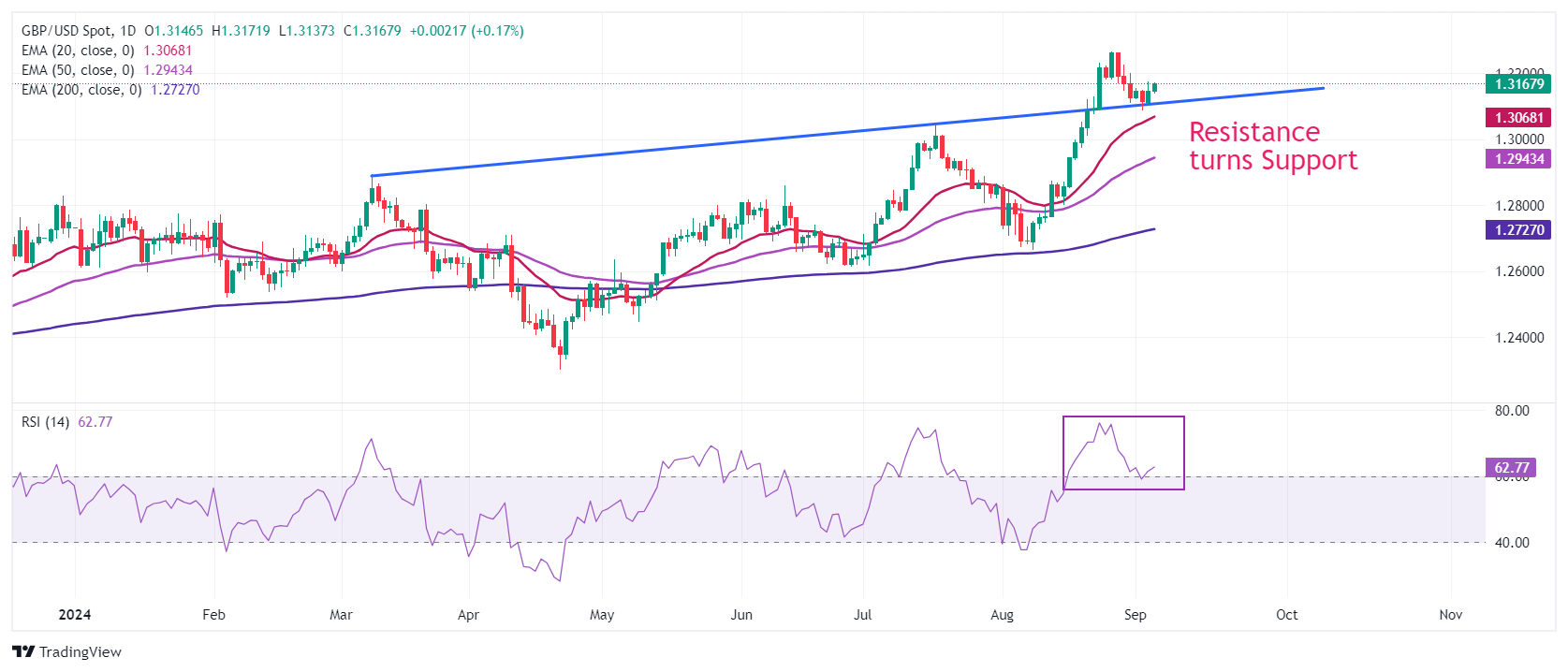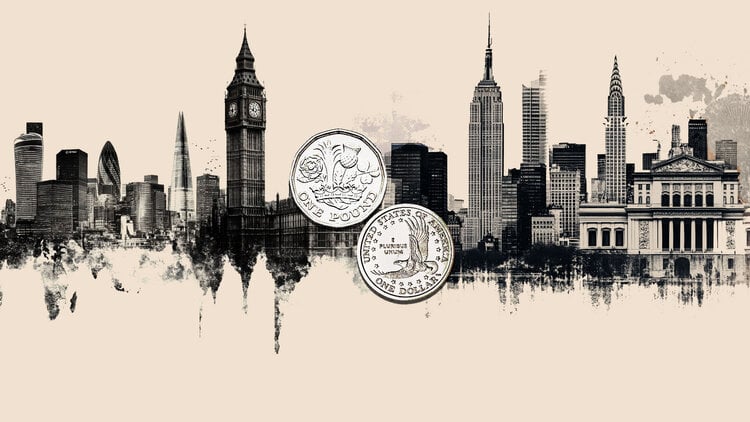- The British Pound gained against the US Dollar as a decline in US job openings in July raised the chances of a big interest rate cut by the Fed.
- Weak US job openings data raises red flags about labor market conditions.
- Investors see the BoE leaving interest rates unchanged at 5% at its meeting this month.
The British Pound (GBP) is up above 1.3150 against the US Dollar (USD) in Thursday’s London session. The GBP/USD pair is looking to extend Wednesday’s rally after weak US JOLTS job openings data for July put the US Dollar (USD) on the defensive. The US Dollar Index (DXY), which tracks the value of the Greenback against six major currencies, is falling near the crucial support of 101.00.
Job openings data released on Wednesday showed new job openings posted by U.S. employers stood at 7.67 million, the lowest level in more than three and a half years. Signs of a slowing labor market supported expectations that the Federal Reserve could begin the process of easing policy aggressively.
According to the CME FedWatch tool, the probability that the Fed will begin to cut interest rates by 50 basis points (bps) to 4.75%-5.00% at the September meeting has risen to 41% from 34% a week ago.
Looking ahead, the US Non-Farm Payrolls (NFP) data for August, due out on Friday, will be the main trigger for the US Dollar. The importance of the US labour market data has increased significantly as the Fed appears to be more concerned with preventing job losses as there is growing evidence that inflationary pressures remain on track to return sustainably to the bank’s 2% target.
In the American session on Thursday, investors will focus on the ADP Employment Change and the ISM Services Purchasing Managers’ Index (PMI) for August. Initial Jobless Claims data for the week ending August 30 will also be important.
Daily Market Movers Roundup: Sterling Outperforms Major Peers
- The British Pound is performing strongly against its major peers on Thursday. The British currency is strengthening as the United Kingdom’s (UK) upbeat economic outlook has raised market expectations that the Bank of England’s (BoE) policy easing cycle could be shallower this year compared to that of other central banks.
- The final estimate of the S&P Global/CIPS PMI data released on Wednesday showed that overall economic activity in the UK expanded at a faster pace in August. The survey data showed that activity rose at the fastest pace since April, driven by strong expansion in both the manufacturing and service sectors.
- Financial market participants expect the BoE to cut interest rates only once in the remainder of the year. The BoE pivoted to policy normalization in August. The central bank is expected to leave interest rates unchanged at 5% this month, and markets expect another cut in November or December.
- The British Pound will be influenced by market sentiment and speculation about BoE interest rate cuts in the absence of top-tier UK economic data. Next week, investors will focus on employment data for the quarter ending in July and monthly Gross Domestic Product (GDP) data for July.
Technical Analysis: British Pound Rebounds From Weekly Low Of 1.3090
The British Pound is bouncing near 1.3150 from a fresh weekly low of around 1.3090 against the US Dollar. The GBP/USD pair is gaining strength after finding strong buying interest near the breakout region of an ascending trend line drawn from the December 28, 2023 high of 1.2828 on the daily time frame.
The short- and long-term upsloping Exponential Moving Averages (EMAs) suggest a strong bullish trend.
The 14-day Relative Strength Index (RSI) is bouncing off 60.00, suggesting a resumption of bullish momentum.
Looking up, Cable will face resistance near the psychological level of 1.3500 and at the February 4, 2022 high of 1.3640 if it breaks above a fresh two-and-a-half-year high of 1.3266. On the downside, the psychological level of 1.3000 emerges as a crucial support for the British Pound bulls.
The British Pound FAQs
The Pound Sterling (GBP) is the oldest currency in the world (886 AD) and the official currency of the United Kingdom. It is the fourth most traded currency unit in the world, accounting for 12% of all transactions and an average of $630 billion a day, as of 2022.
Its key currency pairs are GBP/USD, also known as the “Cable,” which accounts for 11% of the forex market, GBP/JPY, or the “Dragon” as it is known to traders (3%), and EUR/GBP (2%). The British Pound is issued by the Bank of England (BoE).
The most important factor influencing the value of the British Pound is the monetary policy decided by the Bank of England. The Bank of England bases its decisions on achieving its main objective of “price stability”, i.e. a stable inflation rate of around 2%. Its main tool for achieving this is the adjustment of interest rates.
When inflation is too high, the Bank of England tries to contain it by raising interest rates, making credit more expensive for individuals and businesses. This is generally positive for the GBP, as higher interest rates make the UK a more attractive place for global investors to park their money.
When inflation is too low, it is a sign that economic growth is slowing. In this scenario, the BoE will consider lowering interest rates to make credit cheaper, so that companies borrow more to invest in growth-generating projects.
The data released gauges the health of the economy and can influence the value of the Pound. Indicators such as GDP, manufacturing and services PMIs, and employment can influence the direction of the Pound.
A strong economy is good for the British Pound. Not only does it attract more foreign investment, but it may encourage the Bank of England to raise interest rates, which will directly strengthen the British Pound. Conversely, if economic data is weak, the British Pound is likely to fall.
Another significant indicator for the pound is the trade balance. This indicator measures the difference between what a country earns from its exports and what it spends on imports during a given period.
If a country produces highly sought-after exports, its currency will benefit exclusively from the additional demand created by foreign buyers who wish to purchase these goods. Therefore, a positive net trade balance strengthens a currency and vice versa for a negative balance.
Source: Fx Street
I am Joshua Winder, a senior-level journalist and editor at World Stock Market. I specialize in covering news related to the stock market and economic trends. With more than 8 years of experience in this field, I have become an expert in financial reporting.








